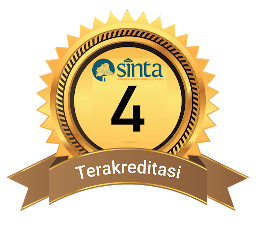Development of Structured Assignment Sheet on Reaction Rate Materials To Train Problem-Solving Skills
DOI:
10.29303/cep.v4i2.2311Published:
2021-08-14Issue:
Vol. 4 No. 2 (2021): Edisi Khusus Penelitian Pengembangan dalam rangka ulang tahun CEP yang ke 4Keywords:
Structured Assignment Sheet (SAS), Problem-Solving Skills (PSS), Reaction Rate.Articles
Downloads
Additional Files
How to Cite
Abstract
This study aims to determine the feasibility of a Structured Assignment Sheet (SAS) on the reaction rate material to practice student Problem-Solving Skills (PSS) in terms of validity, practicality, and effectiveness criteria. The method used in this research is Research and Development (R&D). The instruments used were validation sheets, student response questionnaires, and problem-solving skills test sheets. SAS that developed was tested on 15 students of XI grade who had received material on reaction rates at SMAN 1 Manyar and SMA Assa'adah Bungah. The SAS's validity was obtained based on the assessment of two Chemistry lecturers of Universitas Negeri Surabaya and two chemistry teachers at SMAN 1 Manyar and SMA Assa'adah Bungah. The validity has obtained a percentage of content validity of 92% and constructs validity of 90%, both of them were included in the very valid category. The practicality of the SAS was obtained through student responses. It obtained a positive response of 100% in the very practical category. The effectiveness of SAS was obtained through an N-Gain score of 0.8 with high criteria. That shows that the SAS-PSS developed is suitable for use in the learning process.
References
Adhitama, N., & Sudarmin. (2015). IMPLEMENTASI QUANTUM LEARNING BERBANTUAN MIND MAPPING WORKSHEET UNTUK MENGUKUR KEMAMPUAN KOMUNIKASI DAN HASIL BELAJAR PESERTA DIDIK. Unnes Science Education Journal , 1022-1030.
Andriani, A. (2016). Peningkatan Kemampuan Pemecahan Masalah Matematika mahasiswa FMIPA Pendidikan Matematika Melalui Model Pembelajaran IMPROVE. Jurnal Tarbiyah .
Archambault, J. (2008). The Effect of Developing Kinematics Concepts Graphically Prior to Introducing Algebraic Problem Solving Techniques Action Research Required for the Master of Natural Science Degree with Concentration in Physics. USA: Arizona State University.
Bransford, J. D., & Stein, B. S. (1993). The Ideal Problem Solver: A Guide for Improving Thinking, Learning, and Creativity (2 ed.). New York: W.H. Freeman.
BSNP. (2014). Instrumen Penilaian Buku Teks Pembelajaran Kimia untuk Peserta Didik SMA/MA. Jakarta: Badan Standar Nasional Pendidikan.
Jehabun, S., Gunur, B., & Kurniawan, Y. (2020). KECERDASAN EMOSIONAL DAN MINAT BELAJAR MATEMATIKA TERHADAP KEMAMPUAN PENALARAN MATEMATIS SISWA . Jurnal Pendidikan Matematika , 25-38.
Jonnasen, D. H., & Hernandez-Serrano, J. (2002). Case-based reasoning and instructional design: Using stories to support problem solving. Educational Technology: Research and Development , 65-77.
Kundi, S. (2013). PENGARUH PENGGUNAAN LEMBAR KEGIATAN SISWA TERSTRUKTUR TERHADAP HASIL BELAJAR FISIKA SISWA KELAS XI IPA SMA NEGERI 1 POL-UT KABUPATEN TAKALAR. Jurnal Pendidikan Fisika , 1 (3), 219-225.
Marthafera, P., Melati, H. A., & Hadi, L. (2018). DESKRIPSI PEMAHAMAN KONSEP SISWA PADA MATERI LAJU REAKSI. Jurnal Pendidikan dan Pembelajaran Khatulistiwa , 7 (1).
Mukhopadhyay. (2013). Problem Solving In Science Learning - Some Important Considerations of a Teacher. Journal Of Humanities And Social Science , 21-25.
Novitasari, N., Ramli, M., & Maridi. (2015). Penyusunan Assessment Problem Solving Skills untuk Siswa SMA pada Materi Lingkungan. Seminar Nasional XII Pendidikan Biologi FKIP UNS 2015 , 519-525.
Prastiwi, M. D. (2018). Kemampuan Pemecahan Masalah Pada Siswa Kelas VII SMP. Jurnal Pendidikan Sains , 6 (2), 98-103.
Riduwan. (2015). Skala Pengukuran Variabel-Variabel Penelitian. Bandung: Alfabeta.
Sugiyono. (2015). Metode Penelitian Kuantitatif, Kualitatif, dan R&D. Bandung: Alfabeta.
Sulistyowati, E. (2012). Implementasi Kurikulum Pendidikan Karakter. Yogyakarta: Citra Aji Pratama.
Trilling, B., & Fadel, C. (2009). 21st Century Skills: Learning for Life in Our Times. San Francisco: Jossey-Bass.
Widodo, T., & Kardawati, S. (2013). HIGHER ORDER THINKING BERBASIS PEMECAHAN MASALAH UNTUK MENINGKATKAN HASIL BELAJAR BERORIENTASI PEMBENTUKAN KARAKTER SISWA. Cakrawala Pendidikan , 161-170.
Yarmani, A. (2016). Analisis Kemampuan Pemecahan Masalah Matematics Siswa Kelas XI MIPA SMA Negeri 1 Kota Jambi. Jambi: Universitas Batanghari.
Author Biographies
Vena Salsabila, Universitas Negeri Surabaya
Suyono Suyono, Universitas Negeri Surabaya
License
Authors who publish with Chemistry Education Practice agree to the following terms:
- Authors retain copyright and grant the journal right of first publication with the work simultaneously licensed under a Creative Commons Attribution License 4.0 International License (CC-BY-SA License). This license allows authors to use all articles, data sets, graphics, and appendices in data mining applications, search engines, web sites, blogs, and other platforms by providing an appropriate reference. The journal allows the author(s) to hold the copyright without restrictions and will retain publishing rights without restrictions.
- Authors are able to enter into separate, additional contractual arrangements for the non-exclusive distribution of the journal's published version of the work (e.g., post it to an institutional repository or publish it in a book), with an acknowledgement of its initial publication in Chemistry Education Practice.
- Authors are permitted and encouraged to post their work online (e.g., in institutional repositories or on their website) prior to and during the submission process, as it can lead to productive exchanges, as well as earlier and greater citation of published work (See The Effect of Open Access).






